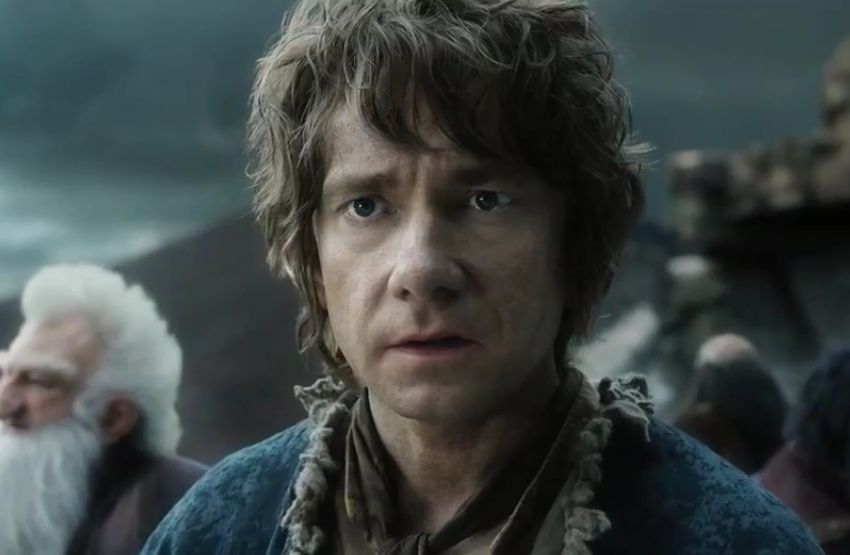Welcome back to the chapter-by-chapter reread of The Hobbit, which is now concluded with this discussion of The Battle of the Five Armies, a.k.a. the adaptation of the last seven chapters.
Previously: we reread The Hobbit chapter-by-chapter (and The Lord of the Rings before it). I liked An Unexpected Journey more than I expected, but found The Desolation of Smaug to be like butter that has been scraped over too much bread—which is apparently the reverse of the general critical consensus.
What about this movie, the last adapting The Hobbit and the last Tolkien movie we can expect for the foreseeable future? (Before someone makes the inevitable Silmarillion-in-fifty-parts joke: it would have to be literally over the dead bodies of both Christopher Tolkien and his son, and even then I wouldn’t count on it.) Behind the jump, I’ll discuss what I thought the movie was trying to do, how well it achieved that, and a bit of what might have been. As always, spoilers for the movies and everything Tolkien (The Hobbit, The Lord of the Rings, The Silmarillion, and various posthumous tidbits).
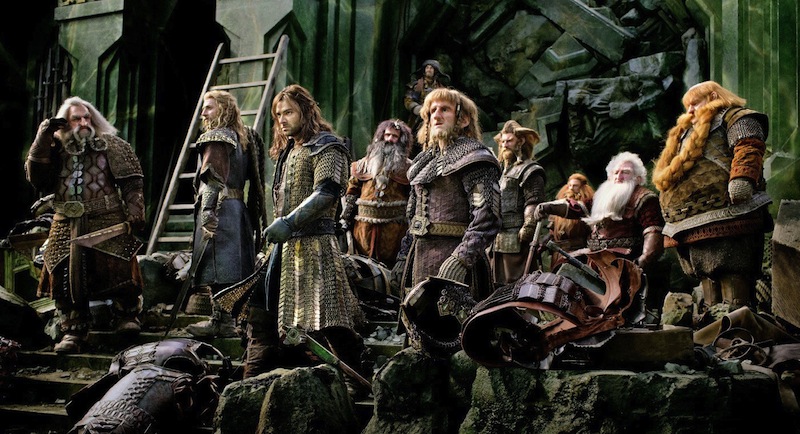
What I Think the Movie Was Trying to Do
Let’s start with what I think was behind some of the changes to the movie—which are, by and large, reasonable things to want to address, so credit where credit is due. Well, except the whole concept of making three movies in the first place. (Obligatory link to 538 comparing how many minutes per page were expended in a number of recent book adaptations.)
First: there are literally no women in Tolkien’s book. None. And even when you add in LotR’s Appendices for this time period, that only gets you Galadriel. So creating Tauriel and giving both of them something to do, that makes sense.
And while there’s basically no detail in either The Hobbit or LotR about Galadriel’s abilities in battle, the hints we get are tantalizing. Way back in the day, I asked people what missing scene they’d like to read, and my own choice was Galadriel throwing down the walls of Dol Guldur after the Ring was destroyed. I wanted to see Galadriel being powerful and effective and active, something she’s denied in the text proper. Similarly, though Tauriel was created out of whole cloth for the movie, I liked her more than I expected in the second movie, and I thought her character had a lot of promise.
On another note, as we discussed in the reread, the Battle of the Five Armies uses a lot of elements that later showed up in LotR’s battles: unnatural darkness, evil flying creatures, unexpected aid from ground forces, Eagles, a pattern of strong reversals, and a POV character being knocked out. In addition, both this battle and Helm’s Deep take place in relatively constrained spaces before a fortified entrance to a geological formation. So it makes sense that the movie writers would want to avoid a been-there done-that battle scheme and give watchers something different.
Finally, any consideration of The Hobbit in the context of LotR must grapple with the different tones between them. This is more of an issue early, but still something I was wondering about—we recently read The Hobbit out loud to SteelyKid (now six and in first grade), and I happened to read her the last chapter, which is pretty sunny.
So how did this work out in practice? Well…
The tl;dr Version
The Good
Martin Freeman. The women of Lake-town, who said, “Hey, we’re going to fight too!” when they were bundled off to the caves. Alfred not, contrary to my expectation, getting a gruesome death. Thorin, Fili, and Kili ending up dead, as is only canonically right and proper. The mostly-empty disarray of Bag End, which set the right tone of dislocation and dark-but-not-too-dark, leading up to the ending that transitioned into Fellowship.
The So-So
I appreciated the swiftness of opening in medias res with Smaug attacking Lake-town—in effect, that sequence was the prologue, breaking the pattern of a flashback taking that position—but it was a little disorienting, especially since I hadn’t rewatched the movies since I saw Desolation in theaters last year.
The Bad
Basically… everything else.
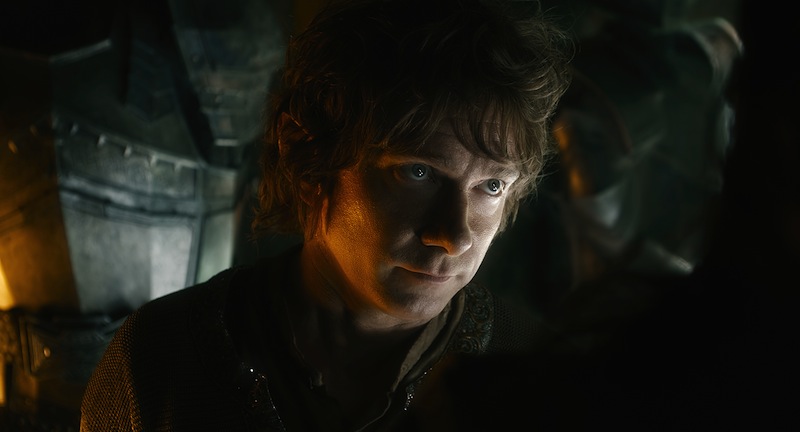
The Much, Much Longer Version
Smaug
Since this opens the movie, might as well talk about it first.
It’s nice that Smaug got to talk smack at Bard a bit. And there was a lot of fire and swooping and whatnot.
But two things distracted me. First: all that setup about the giant fixed crossbow on the roof in the last movie, and then it’s not even mentioned here? Second: all of my parental instincts were so viscerally enraged at Bard using his kid as a guide for his arrow that I could barely see straight. I know, I know, normally I’m very much on board with “save the world not an individual,” but it seems unlikely to me that a shoulder would actually work for that purpose, so it was just the filmmakers tossing in “hey, terrified kid in peril!” to make things more ~~dramatic~~. Plus, doing that to your kid!
Otherwise, as I noted above, this was effectively the prologue, and having it set off like that further emphasized to me that the three-movie structure was all wrong. Two movies, and split them at Bilbo getting to the bottom of the tunnel and Smaug revealing himself.
The Women
Like I said, I am bang on board with the idea of (1) having women in the movie and (2) giving them something to do. But.
Both Galadriel and Tauriel end up having to be rescued by men because they are distracted by their feelings for a man—Tauriel has to be rescued twice, once by Kili and once by Legolas. Galadriel is too busy cooing over Gandalf to get up off the ground and fight (it remains really weird to me that the filmmakers ship them), and Tauriel’s quite successfully whirlwinding her way through orcs until she starts calling for Kili instead of paying attention to her surroundings.
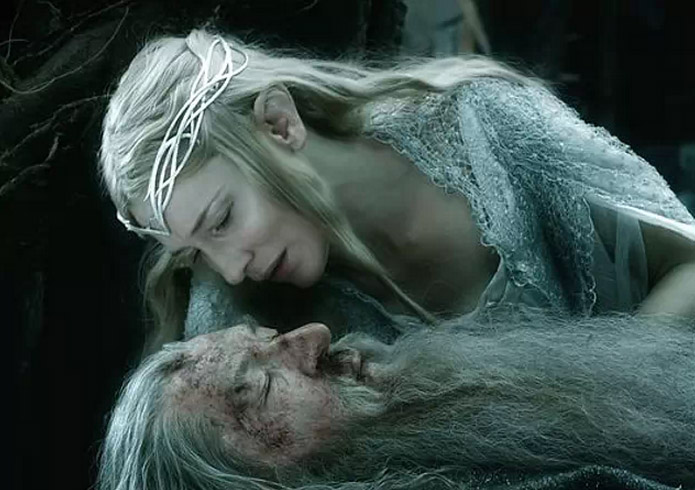
Worse, when Galadriel finally gets back into things, her exercise of power makes her temporarily go to the dark side—her clothes and hair change to black, the lighting goes weird, all that. This isn’t a temptation scene like Frodo offering her the Ring; she’s wielding her ordinary powers against evil, and ought to be able to do that without being scarily dangerous, just like Gandalf does.
Otherwise I can’t muster up many thoughts or feelings about the Dol Guldur section, except that it was surprisingly short (not an objection!). Yes, we already know from prior movies that the Nazgûl being there makes no sense, and yes, we already know that Sauron did not have to be a dark and fiery spirit because he had a body at this point in canon. At this point, I just shrugged and moved on.
The Battle
I was completely unable to follow the geography here, which could just be me, because I’m not good at that kind of thing generally. But it was distracting and made it harder for me to sink into the movie.
First, one of the sources of orcs was Mount Gundabad. This does actually appear on Tolkien’s maps, up at the top end of the Misty Mountains, but I had no fucking clue where it was when I was watching the movie.
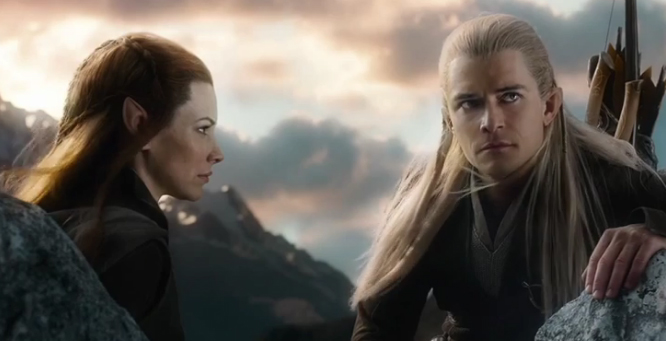
(I here delete several paragraphs trying to figure out if it was remotely possible for Legolas and Tauriel to have got there and back. The upshot is: yes, if they are able to make themselves magically near-weightless while riding double, just as when walking on snow, and if their horse is several times as good as a present-day horse trained for endurance riding and can, I don’t know, eat lembas to survive.)
Second, I am fairly sure I heard someone claim the Mountain was strategically important because Rivendell was to the north. This was probably a vast simplification of the explanation in Appendix A of LotR:
Among many cares [Gandalf] was troubled in mind by the perilous state of the North; because he knew then already that Sauron was plotting war, and intended, as soon as he felt strong enough, to attack Rivendell. But to resist any attempt from the East to regain the lands of Angmar and the northern passes in the mountains there were now only the Dwarves of the Iron Hills. And beyond them lay the desolation of the Dragon. The Dragon Sauron might use with terrible effect. How then could the end of Smaug be achieved?
…
So it was that when the War came at last the main assault was turned southwards; yet even so with his far-stretched right hand Sauron might have done great evil in the North, if King Dáin and King Brand had not stood in his path.
But, take “where the hell is Gundabad?”; add “did they move the Lonely Mountain to be south of Rivendell?!”; and then toss in “why are there mountains apparently within view of, ahem, The Lonely Mountain,” and I was just completely adrift in space.
I also found the logistics of the battle very confusing. As I said: I recognize the impulse behind moving the focus out of the valley before the Front Gate. But it made keeping track of the action below difficult. It seems that the movie decided to make five armies by ditching the wolves, which are indeed the fifth in the book, and adding another orc army. So after the second batch of orcs showed up, I was convinced that there was going to have to be a late arrival of another set of ground forces from who-knows-where, because from what I remembered seeing of Thranduil, Dáin, and Bard’s forces, they were already outnumbered by the first army, and then when another arrives… even the Eagles and Beorn didn’t seem sufficient to take on an entire additional army, especially as we only got the tiniest glimpse of them in action.
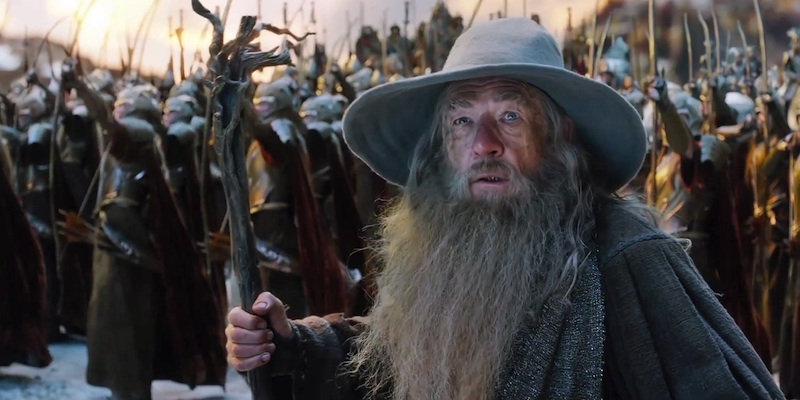
I realize the justification of making the focus on the individual fights was that the orcs needed their leader making plans, but “mindless slaughter achieved by sheer force of numbers” seems entirely within the capabilities of your ordinary orc, leader or no. I’m not saying this couldn’t have worked, I’m saying that what I was shown didn’t seem to add up.
Okay, enough of that. What did I think of the emotional weight of moving the fight to a series of one-on-one confrontations?
Fili and Kili… enh. I honestly prefer the image of them “fall[ing] defending [Thorin] with shield and body,” to an unnecessary display of wanton cruelty (Fili) and an interminable slo-mo impalement trying to save someone who only needed help because she got distracted looking for you (Kili). But, whatever.
Thorin: the fight on the ice was different and had some neat bits, but when he managed to get Azog under the ice and was just standing there afterward, all I could do was mentally chant at him, “get off the ice, get off the ice, get off the ice!” So it was kind of disappointing when I turned out to be right.
At least the movie preserved the good bits of Thorin’s farewell to Bilbo? I didn’t think it was as good as Boromir’s death scene, but as you can tell I was seriously emotionally detached from the movie at this point, so that context makes it hard to do a fair comparison of the scenes on their own. (The farewell, and this movie in general, also tossed quite a bit of bait to the Bilbo/Thorin shippers. Not my ship, and I honestly hadn’t seen the potential for it before this movie, but here, yeah.)
Also, I entirely lost track of the fourth dwarf in there; I have no idea where he was during Thorin’s fight. I liked that Bilbo threw rocks, but I hated that he didn’t get to yell “The Eagles are coming!” in the midst of battle and get everyone else to take up the cry. One of the most stirring high-fantasy moments of the book, gone.
Really, my stirring high-fantasy images from the end of the book are: “The Eagles are coming!”; Fili and Kili dying to protect Thorin; and Thorin buried under the Mountain, the Arkenstone on his breast and Orcist on his tomb, provided by Bard and Thranduil. And I didn’t get any of those. They are minor notes, I admit, but I missed them.
Speaking of stirring high-fantasy images: this isn’t in The Hobbit proper, but as I’ve said before, I always had a fondness for Dáin based on what we get out of the LotR appendices: killing Azog and looking into Moria, and also dying during the War of the Ring, “standing over the body of King Brand before the Gate of Erebor until the darkness fell.” So, as you can imagine, I was not impressed with his portrayal in this movie.
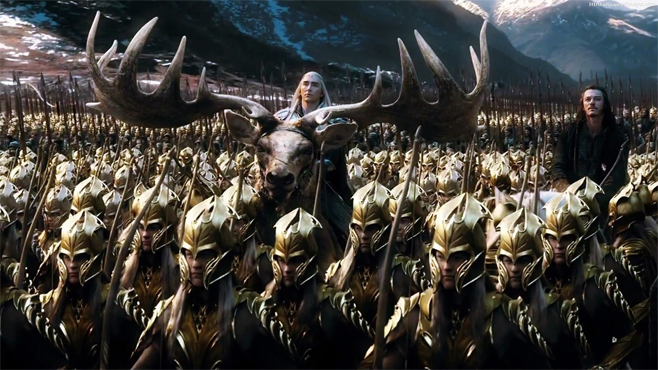
Let’s go back to the big picture. The main things the Battle needed to do were: redeem Thorin (check); defeat the Orcs (check); reestablish the King under the Mountain and Dale (check). Thorin’s redemption scene was, of course, vastly overdone, but I expected that: the filmmakers hire by-and-large excellent actors[*] and then too often don’t trust them to act.
[*]Except maybe finding a good fit for the actors playing the Elves. In previous discussions, I’ve said how puzzling I find Elrond and Thranduil, and Legolas was really remarkably wooden in this movie—I genuinely forgot that he was supposed to be in love with Tauriel until the end. Probably for that reason, all the emotional arcs involving Thranduil made no impression on me.
The movie did, however, make a bit of a puzzling choice to me when everyone was trying to convince Thorin to give up some of the treasure: the promise to aid Lake-town was indeed under duress (unlike in the book, so I had to go back and check), and he had a point that it was therefore not valid. Yet people kept harping on how he should keep his word instead of arguing that it was the just thing to do, both in terms of the wealth of Dale being mingled in the dragon’s hoard and in terms of the dwarves having roused the dragon and therefore having been a cause of the town’s destruction. I felt it would have been a stronger demonstration of Thorin’s irrationality if the arguments had been crafted better. But then, I’m a lawyer, I would put emphasis on that.
The Battle also needed to be spectacle, and there were points there when I was distinctly not impressed with its technical aspects. A lot of the CGI creatures were noticeably terrible when they were interacting with people: Thranduil’s reindeer/elk/moose/whatever in battle was particularly bad, as was Legolas’ dismount from the giant bat. And when the Elves leapt into battle, vaulting over the Dwarves and their shield-wall, it looked like wire-work out of a wuxia movie: cool, but entirely out of place. I expected better, this many years after LotR.
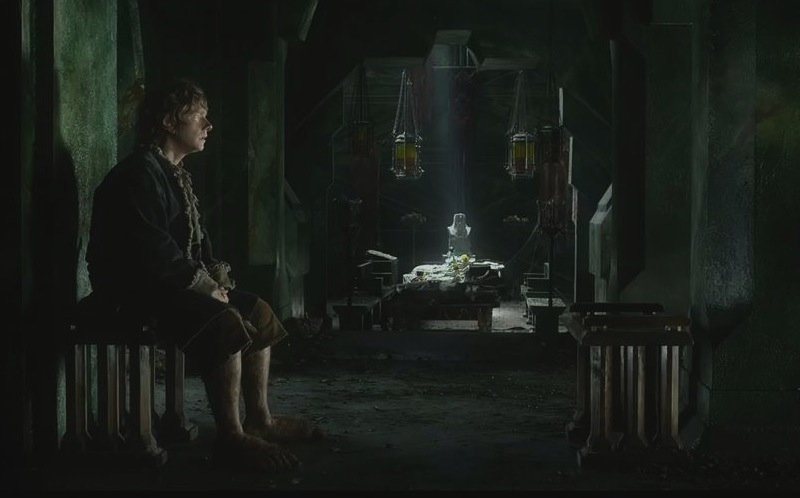
What Might Have Been
Honestly, I still would really have liked the orc-dwarf stuff to hew closer to Appendix A in LotR. Thrór’s death is so great in the book, much more interesting than yet another death in battle. Show him going into Moria—we remember Moria from Fellowship very well, after all, so that right there creates tension already. Show us his companion waiting anxiously near the entrance. Show us Azog tossing Thrór’s head and body out, head branded with “Azog,” and tossing a few coins at the companion, telling him it was his fee for bringing the news to other dwarves. That would be very compelling, but also the kind of grim yet individual action that seems right up the alley of the filmmakers.
Then the big battle before Moria, and if Azog is killed there—I’d even accept a change to Thorin doing the killing—Bolg can be the single antagonist driving the action in the first movie, but because he’s pursuing revenge. I would have found that a more interesting motivation than “Azog is a particularly evil orc with a particularly strong hate for the line of Durin, for no apparent reason.”
Structurally, everything else could pretty much proceed as it was in the big picture. Naturally there are lots of tweaks I’d like to make in the execution (she says, looking back at the prior couple thousand words of this post, never mind the other two movie posts), but that’s the biggest content change I would have liked. And the one I’m most puzzled about not existing, frankly.
I know it’s traditional at this point to wish for the fan-edit that makes it two movies instead of three, but honestly I think I’ll just look for the Bilbo-only edit, since the things I genuinely liked about these adaptations pretty much boil down to Bilbo, Gollum, and Smaug. Those are excellent and I’m glad to have them, but not enough to wade through everything else surrounding them.
What about you all? What’s your personal high and low points of these movies; are you glad you saw them; what would you have liked to be different, on whatever scale?
Kate Nepveu was born in South Korea and grew up in New England. She now lives in upstate New York where she is practicing law, raising a family, and (in her copious free time) writing at Dreamwidth and her booklog. Elsewhere on Tor.com, she is currently rereading Jonathan Strange & Mr Norrell.










